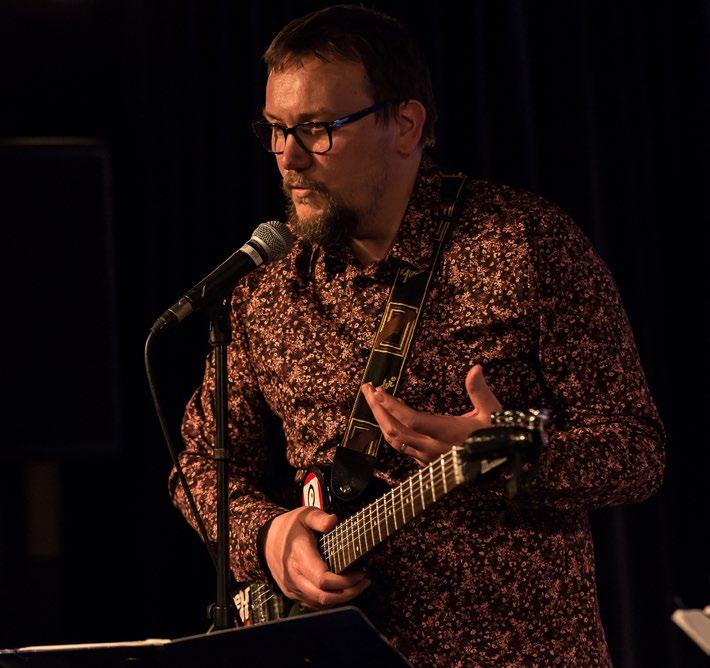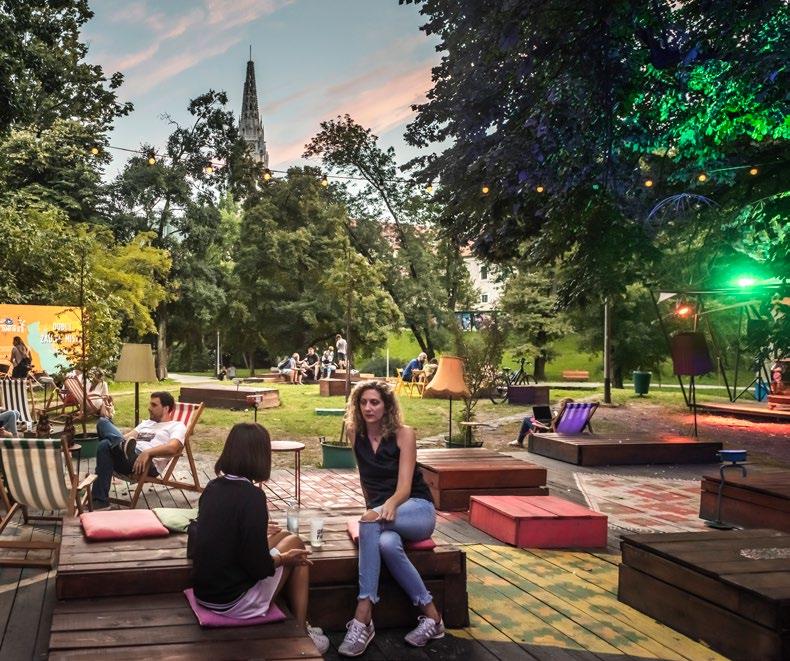
9 minute read
Five New Faces in Croatian Culture
5 neW Faces in croaTian culTure
The Croatian creative scene is a constant ferment of new voices and new talents. Here is our pick of five names to watch in 2021.
Advertisement
Lorna Dalibor Ivan
pHoTogrApHy: lorNA KIjurKo ljubljana-born, Rovinj-raised photographer lorna Kijurko has been turning a lot of heads with her fresh take on the art of the nude. Working primarily in black and white, she has carved out a unique aesthetic niche since her first solo exhibition “liveliness” in 2016. the Živost series has since assumed canonical proportions with its intimate, atmospheric and empowering images of female nudes – lying on beaches, running between tall wild grasses, or caught in almost candid-camera style in various locations. Revised and expanded, Živost was given a reprise in Zagreb’s lauba Gallery in 2020; and all of a sudden lorna Kijurko was someone the nation’s lifestyle magazines couldn’t get enough of. As she told one interviewer, “for me the nude is not about taking clothes off, its about opening the soul”. increasingly in demand as a portrait and fashion photographer, and with an already much-hailed portfolio of travel photographs taken during trips to india, one suspects that there is much more to come from Kijurko in the future.
ANIMATED FIlM: DAlIbor bArIć Croatia has been known for its outstanding tradition in animated film ever since Zagreb’s Dušan Vukotić won an oscar for his film the surrogate in 1962. Breaking into the long list for best animated feature in 2021’s oscars was Zagreb-based film-maker Dalibor Barić, whose tortuouslytitled Accidental luxuriance of the translucent Watery Rebus (slučajna raskoš prozirnog vodenog rebusa), offered a seductive mixture of dystopian sci-fi and brooding philosophical drama. Premiered at the Annecy Film Festival last year, the film takes a critical look at corporate power and the all-seeing eye of contemporary technology. Rendered in a vivid style that blends lurid comic-strip aesthetics with photomontage, it looks like a cross between an Adam Curtis documentary and a woozy dream, and is a long way from the cartoon adventures of a Disney or a Pixar. As well as writing and directing a string of animated films over the last ten years, Barić has also directed videos and authored comic strips. Future-angst and techno-terror have always been among his main concerns, as evidenced by his highly admired shorts unknown energies, unidentified emotions; and Amnesiac on the Beach. totally original and slightly mad, Barić is very much a name to watch.

Lana
Liveliness, Lorna Kijurko Domagoj & Hrvoje
jAZZ: IVAN KApEC A long-serving pillar of Zagreb’s jazz and experimental scenes, guitarist and composer ivan Kapec scooped up the critical plaudits in 2020 with his fifth, self-released album Crta (“the line”). Recorded together with Mario Bočić (saxophone), Šimun Matišić (vibraphone), ivar Roban Križić (double bass) and Borko Rupena (drums), it is an eclectic, multifaceted album of many moods and colours. the quintet moves effortlessly from melodic and silky to meditative and melancholy, and can suddenly shift gear to hit a percussive groove or explode into bonkers modern-jazz soloing. the unusual combination of Kapec’s baritone guitar and the other instruments (saxophone and vibraphone especially) gives the album a distinctive tone, occupying a niche between post-rock and the theme music to a hauntingly beautiful art movie. A prolific figure with a huge track record of solo work and collaborative projects behind him, Kapec looks set to be a central figure in Croatian jazz for the foreseeable future.

CoNTEMporAry ArT: lANA sTojIćEVIć one of the most thrilling Croatian artists to emerge in recent years is the Šibenik-born lana stojićević. her photographs directan ambiguous and unsettling gaze towards an Adriatic coast that we normally associate with happy beach holidays. nominated for the prestigious Radoslav Putar art prize in 2021, stojićević has become celebrated for a series of works that provide oblique commentary on the uncontrolled growth of vacation houses along the shore. in her 2018 series Fasada she photographed herself wearing an outlandish pink costume made in imitation of a coastal holiday villa. it continued a theme visited in earlier projects Villa Rosa and Parcela, in which modern apartment developments were reimagined as models, toys or cakes.stojićević has already been feted by the foreign media for sunny side, an arresting series of photographs involving the futuristic swimming pool of the hotel Zora in Primošten. using both the real pool and models of it reconstructed to look like a flying saucer,stojićević’s photographssuggest a sci-fi scenario that plays eloquently on the modernist aspects of the Adriatic landscape.

susTAINAblE FAsHIoN: DoMAgoj & HrVojE boljAr: MIrET Based in Duga Resa near Karlovac, brothers Domagoj and hrvoje Boljar have garnered global media attention for their ecological sneaker brand Miret, picking up a prestigious gong at the 2020 international Design Awards on the way. With a solid background in shoe production thanks to their entrepreneur father Josip, the brothers developed the idea of an environmentally-friendly tennis shoe that would be suitable for natural composting once its wearable life was over. it took them over six years of research to put their shoes into production - the result is a sneaker made of 97% natural materials and in possession of all the relevant eco-certificates. these shoes are more than just a worthy exercise in sustainability – they are also comfortable to wear and stylish to look at, coming in a creative range of styles and hues. Miret’s shoes are not cheap, but the winning combination of good design and good intentions more than justifies the outlay. Check out www.miret.co for full details.
Ivan Kapec, Photo by Vesna Zednik
Sunny Side, Lana Stojičević

5 croaTian books You musT read in 2021
There’s a bumper crop of Croatian books due out in 2021. Part of this glut is thanks to the launch of Sandorf Passage, a US-based imprint committed to publishing the best literature from southeastern Europe. Here is our guide to five books to look out for.
MIroslAV KrlEžA. jourNEy To russIA (sANDorF pAssAgE; TrANs WIll FIrTH) it may be almost a hundred years old, but this book by one of Croatia’s greatest writers has definitely been worth waiting for. Miroslav Krleža’s account of a trip to Bolshevik Russia undertaken in the 1920s is nothing short of a modern travel classic. Krleža was himself a communist and had a rather rosy-spectacled view of what leninism meant in practice. however his book’s vivid, frequently critical descriptions of life in Russia under the new regime are both evocatively rendered and full of insight. the description of the journey itself, undertaken by rail across a europe emerging cautiously from a period of war and revolution, is an exhilarating ride in itself. Above all it is a book filled with anxious Wanderlust; reading it in the midst of a pandemic will soon have you yearning to jump on a longdistance train.
IVANA boDrožIć. WE TrADE our NIgHT For soMEoNE ElsE’s DAy (sEVEN sTorIEs prEss; TrANs. EllEN-ElIAs bursAć) the eastern Croatian town of Vukovar is the setting for this gripping noir thriller, a place scarred by war and held in limbo by the failure of post-war politicians to offer a future. As well as a gripping who-and-why-dunnit, the novel is also a subtly feminist text; the main protagonists are women and the challenges they face provide critical reflections on the enduring patriarchal nature of Croatian politics. Bodrožić’s taste for social criticism and her thinly-disguised references to real existing controversies is cloaked in deft plotting and page-turning suspense. A book for the beach, certainly, but a thought-provoking one at that.
bEKIM sEjrANoVIć. FroM NoWHErE To NoWHErE (sANDorF pAssAgE; TrANs. WIll FIrTH) the Croatian-Bosnian-norwegian novelist Bekim sejranović sadly passed away aged 48, just before this, the english translation of his autobiographical debut novel, was released. Bosnian-born sejranović spent his formative years in the Croatian city of Rijeka before the dissolution of Yugoslavia left him without papers. Asylum in scandinavia was offered, and he took it in order to escape an uncertain future. this tale of Yugoslav background, norwegian exile and alcohol-fuelled nights is told with self-deprecating wit and earthy humour. however norway doesn’t feel like home, the narrator spends a lot of time shuttling between jobs, countries and partners, without being sure of where he really belongs. sejranović’s account of the tribulations of the migrant generation is both searingly personal and beautifully told.
robErT pErIŠIć. Horror AND HugE ExpENsEs (sANDorF pAssAgE; DuE IN AuTuMN 2021;TrANs. WIll FIrTH) split raised, Zagreb-based Perišić is one of Croatia’s best contemporary writers, having already garnered critical acclaim for the english translations of his full-length novels no signal Area and our Man in iraq. this, a short-story collection first published in 2002, achieved cult status in Croatia due to its portrayal of a post-war generation negotiating the trials and pitfalls of young adult life in a transitional society. What makes the book relevant twenty years later is the fact that Croatia has not necessarily moved on that much in the intervening period. Financial crisis and covid-19 have kept the millennial generation in suspended animation. Perišić has a great ear for dialogue and captures perfectly the banter of the coffee bars and shopping malls that make up the Croatian scene. And when it comes to conjuring the undercurrents of daily life in southeastern europe, there are few better writers than Perišić.
TATjANA groMAčA. DIVINE CHIlD (sANDorF pAssAgE; DuE IN AuTuMN 2021; TrANs. WIll FIrTH) A searing portrait of a family trying to survive a fractured society, the second novel by acclaimed poet tatjana Gromača involves a child-narrator whose mother is marginalized by society either because of mental illness or the fact that she comes from somewhere else, “the east”, and therefore doesn’t quite fit in – the reader is initially left to guess at the true nature of the family’s problems. Written in minimalist language that only tells you the half of what is on the narrator’s mind, the novel offers a running commentary on a world in which individuals can easily find themselves cast adrift by a society governed by mainstream assumptions. A book of huge symbolic weight, then, but given Gromača’s control of the narrator’s voice it has an intimate and gripping quality that is hard to put down.

Art Park, Photo by Julien Duval, Zagreb Tourist Board Archives

Ivan Rabuzin, On the Hills Primeval Forest, 1960 Photo by Croatian Museum of Naïve Art Archives

Photo by Julien Duval, Zagreb Tourist Board Archives
Murtić 100 25/5 - 18/7 Edo Murtić, Good Day Red, oil on canvas, 100 x 81cm, 1980 Photo by Murtić Foundation Archives






